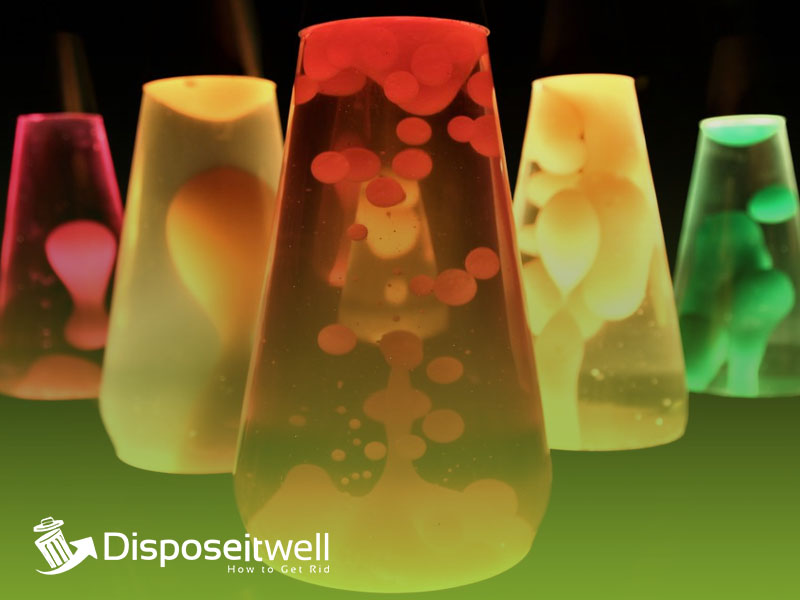Do you have an old lava lamp that you don’t know what to do with? If so, you’re probably wondering how to dispose of it properly.
According to a study conducted by the American Chemical Society, over 200 million lava lamps are sold annually in just the United States, and most are made with a liquid wax and mineral oil combination. When not disposed of properly, the liquid wax and oil can contaminate soil and water supplies
To properly dispose of your lava lamp, start by unplugging it and letting it cool to room temperature. Afterward, take out all components, such as the wax, liquid, etc., and store them in a secure container.
Comply with local environmental regulations when disposing of the wax and liquid. Lastly, bring the base of the lamp to a recycling center or hazardous waste facility, or wrap it in newspaper and toss it in the proper trash bin.
What is in a lava lamp?
A lava lamp is a unique combination of the following elements or parts, together that create a mesmerizing lava lamp that captivates and enthralls.
- Transparent or opaque mineral oil – The mineral oil is used as a medium for the lava lamp, allowing the heavier paraffin wax to float in the liquid. It is either transparent or opaque, depending on the desired effect.
- Paraffin wax – It is the heavier element in the lava lamp and is what creates the “lava” effect, as it rises and falls in the liquid.
- Halogen Lamp – The halogen lamp is used to heat the liquid in the lamp, causing the wax to melt and rise.
- Water – It is a key component of the lava lamp, as it is heavier than mineral oil and lighter than paraffin wax. It helps to create the desired effect of the wax rising and falling in the liquid.
- Carbon tetrachloride – According to Wikipedia, it is a non-flammable liquid that is sometimes used as a substitute for mineral oil in lava lamps. It has a similar effect of creating a medium for the paraffin wax to float in the liquid.
Is the liquid in the lava lamp toxic?
No, the liquid in a lava lamp is not toxic. It is made from a combination of water, mineral oil, and wax. This mixture is non-toxic and safe for children and adults. The wax is responsible for the “lava” part of the lamp, which is a combination of air bubbles that slowly rise through the liquid. The mineral oil helps to keep the wax floating and it also gives the liquid its unique texture.
Although the liquid in a lava lamp is non-toxic, it is not meant to be ingested. If you come into contact with the liquid, it is best to avoid contact with your eyes, nose, and mouth. Additionally, the lamp should not be placed in direct sunlight or near a heat source, as the heat can cause the wax to melt and damage the interior of the lamp.
Safety precautions for disposing of a lava lamp
Lava lamps are a popular decorative item that can add a unique ambiance to any room. However, when disposing of a lava lamp, it is important to take the proper safety precautions to prevent any potential harm to oneself or the environment. Here are some tips for safely getting rid of a lava lamp.
- When handling a lava lamp, wear protective gloves and eye protection to prevent contact with hot wax and prevent burns.
- Do not put a hot lava lamp into a trash can or bin as the heat can cause a fire.
- Dispose of the lava lamp in a sealed plastic bag and place it in an outside trash can or dumpster.
- Never dump the liquid contents of your lava lamp down the sink, toilet, or outdoors as this can be hazardous to the environment.
- If the lava lamp contains a mercury vapor bulb, contact your local hazardous waste disposal center for instructions on proper disposal.
How to Dispose of Lava Lamp?
Getting rid of a lava lamp can be quite a task, but with a bit of guidance, it can be done in no time. The different components of these funky lights can make disposing of them a tricky process, so here’s a quick guide to help you out. Let’s break down the various parts and discuss the best ways to get rid of them.
How to Dispose of the Lava
Lava lamps typically contain a mixture of liquid wax, mineral oil, and a carbon-based dye. To properly dispose of the lava liquid, it must be poured into a sealed plastic container or an absorbent material, such as kitty litter, sawdust, or cornstarch, and taken to a hazardous waste disposal facility. Alternatively, it can also be recycled, if your local recycling center accepts hazardous waste.
How to Dispose of the Glass
The best way to dispose of glass from a lava lamp is to wrap it in several layers of newspaper or paper towels, then place them in a sealed container. If possible, the container should be labeled with the words “glass fragments” so that it can be identified as hazardous waste and disposed of properly.
The container should then be placed in an outdoor trash can or taken to a designated hazardous waste facility.
How to Dispose of the Light Bulb
You’d think with its glass composition, the light bulb would be recyclable. Alas, its wiring and electricity make it a no-go. But don’t fret! You can still say bye to that burnt-out bulb by disposing of it in the trash. J
ust make sure to give it a little protection by wrapping it in something first, so it doesn’t take your trash can with it on its way out.
How to Dispose of the Base
The base and tip of a lava lamp can be made from a variety of materials including plastic, metal, and wiring. Unfortunately, the base is not recyclable and must be placed in the trash. The cap, however, is recyclable and can be tossed into the recycling bin alongside other metal items.
Once you have done this, your old lava lamp will have been disposed of properly! If you’re feeling particularly green, you could even try to reuse the parts for a new project, as the possibilities are endless!
Can we reuse a lava lamp?
If you’re attached to your old lava lamp, you’ll want to make sure it can stay in your life.
- First and foremost, check to see if it works. The lightbulb is often the first to go, so keep an eye out for that. If it’s on its last legs, it might be time to retire it. But don’t worry, you can still find ways to keep it around and make use of the pieces.
- If you have two broken lava lamps, try combining the parts to see if you can make a working one. Most brands are designed to be interchangeable, so that could be a good place to start.
- The glass part of the lava lamp is the most reusable, so properly cleaning it can open up a world of possibilities. From garden decorations to mini fish tanks, you’ll never know what your lava lamp can become.
How Do I Clean Up a Lava Lamp Spill?
Lava lamps are popular decorative pieces that can add a unique and calming ambiance to any room. Unfortunately, accidents can happen, and lava lamp spills can be difficult to clean up. If you have experienced a lava lamp spill, there are certain steps you can take to ensure a thorough and effective cleanup.
- Put on gloves to protect your hands from the hot wax.
- Soak up as much of the wax as possible using paper towels.
- Use a dry cloth to wipe away any remaining residue.
- Place the remaining wax in a glass jar or container and place it in the freezer to harden.
- Once the wax is hard, use a plastic scraper to remove it from the surface.
- Clean the area with a cloth dampened with warm soapy water and rinse with a damp cloth.
- Dry the area thoroughly with a clean cloth.
- If the stain persists, mix a solution of equal parts white vinegar and water, and dab the area with a cloth dampened with the solution.
- Rinse the area with a damp cloth and dry thoroughly.
FAQS
Are lava lamps biodegradable?
The groovy grooves of lava lamps may light up our lives, but, unfortunately, they don’t do the environment any favors. With their primary components of glass, aluminum, and paraffin wax, these lamps are not designed to biodegrade, since glass and aluminum take a long time to decompose naturally.
Are lava lamps toxic if broken?
Lava lamps are not toxic if broken. The wax inside a lava lamp is not toxic, and the liquid it is suspended in is typically a non-toxic mineral oil.
The only hazard associated with a broken lava lamp is if the glass container breaks and leaves sharp edges or splinters. In this case, it is important to clean up any broken pieces with caution and keep them away from children and pets.
Can a lava lamp go bad?
Yes, Lava lamps can go bad over time due to the wax inside becoming too dense or too liquid, the heat source failing, and the lamp being dropped or otherwise damaged. Regular maintenance and careful handling can help prolong the lifespan of a lava lamp.
Conclusion
After reading this article, you now have the knowledge to properly dispose of your lava lamp. Taking the time to ensure that your lamp is disposed of properly isn’t just about protecting the environment, but also about ensuring that no one is harmed in the process. If you follow the steps outlined above, you can be sure that you are getting rid of your lamp in the safest and most responsible way possible.
We truly believe this article was an invaluable source of information and we are grateful that you took the time to read it.

Gemma Alexander has an M.S. in urban horticulture and a backyard filled with native plants. After working in a genetics laboratory and at a landfill, she now writes about the environment and recycling topics.


